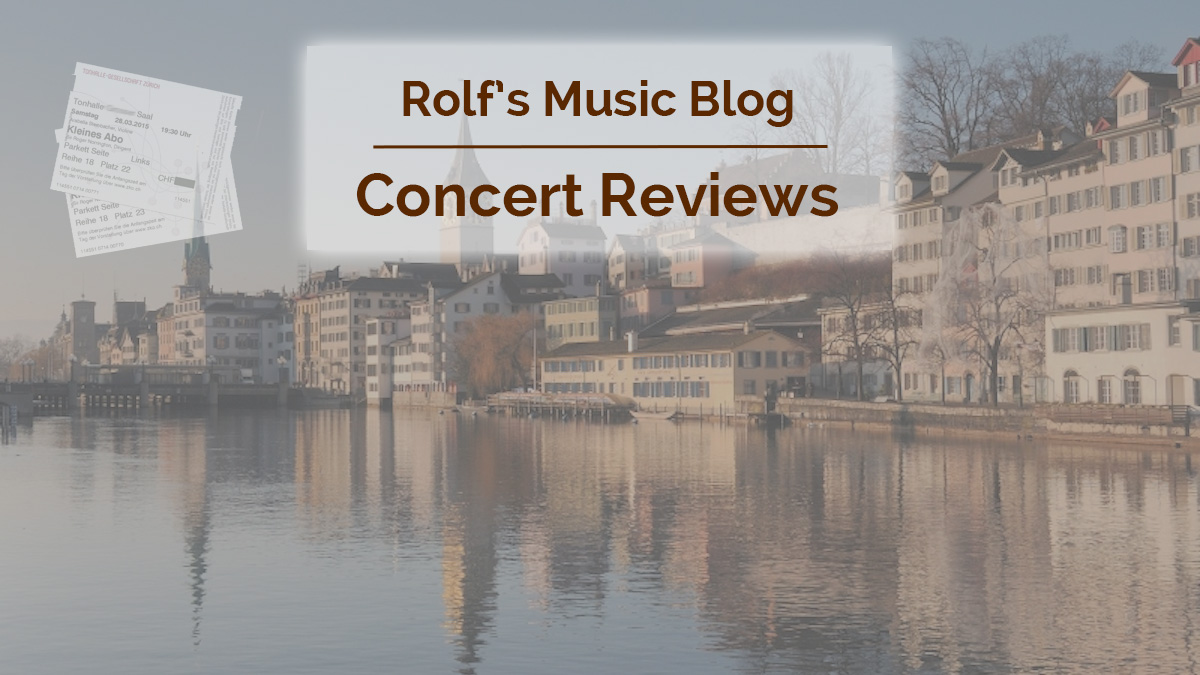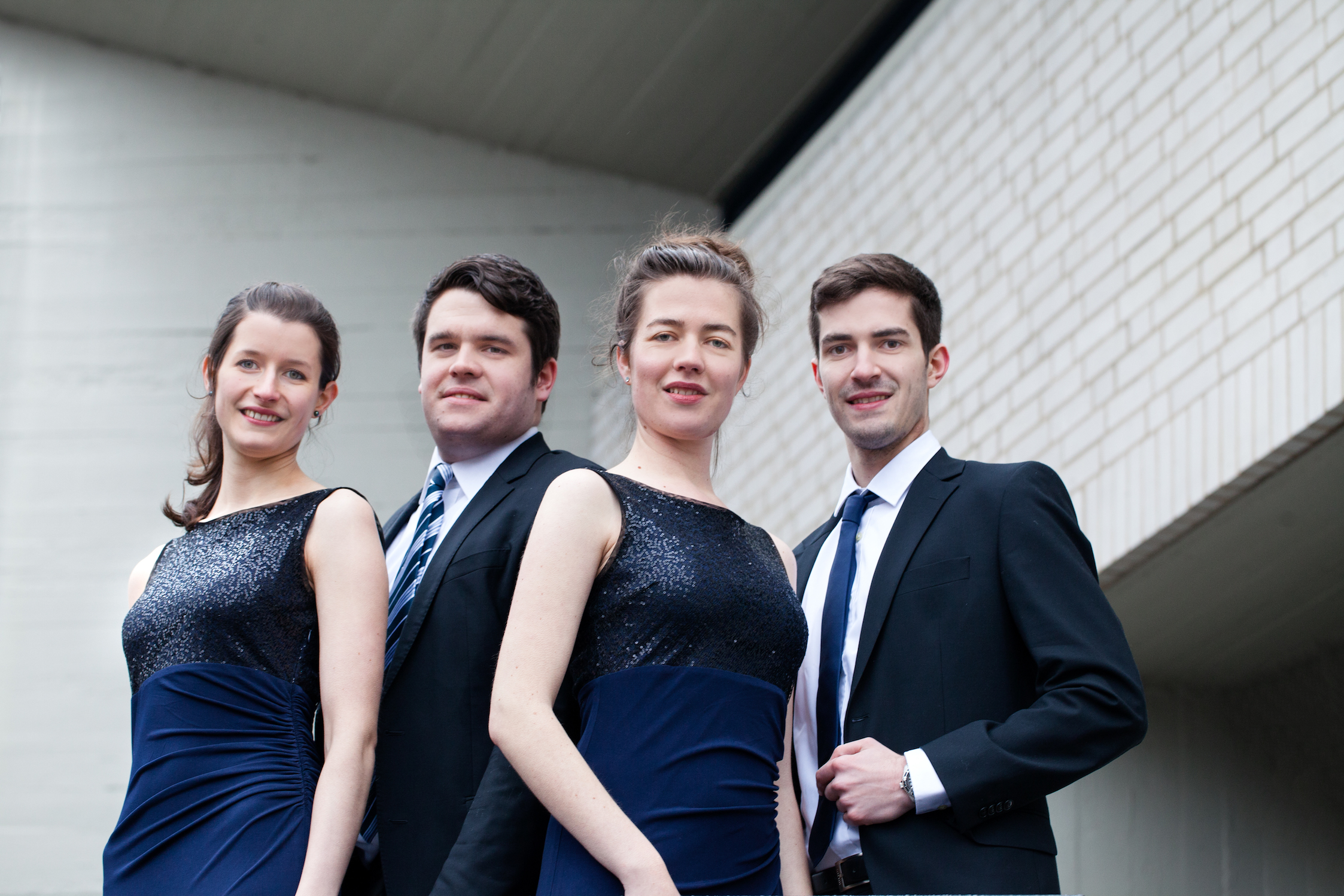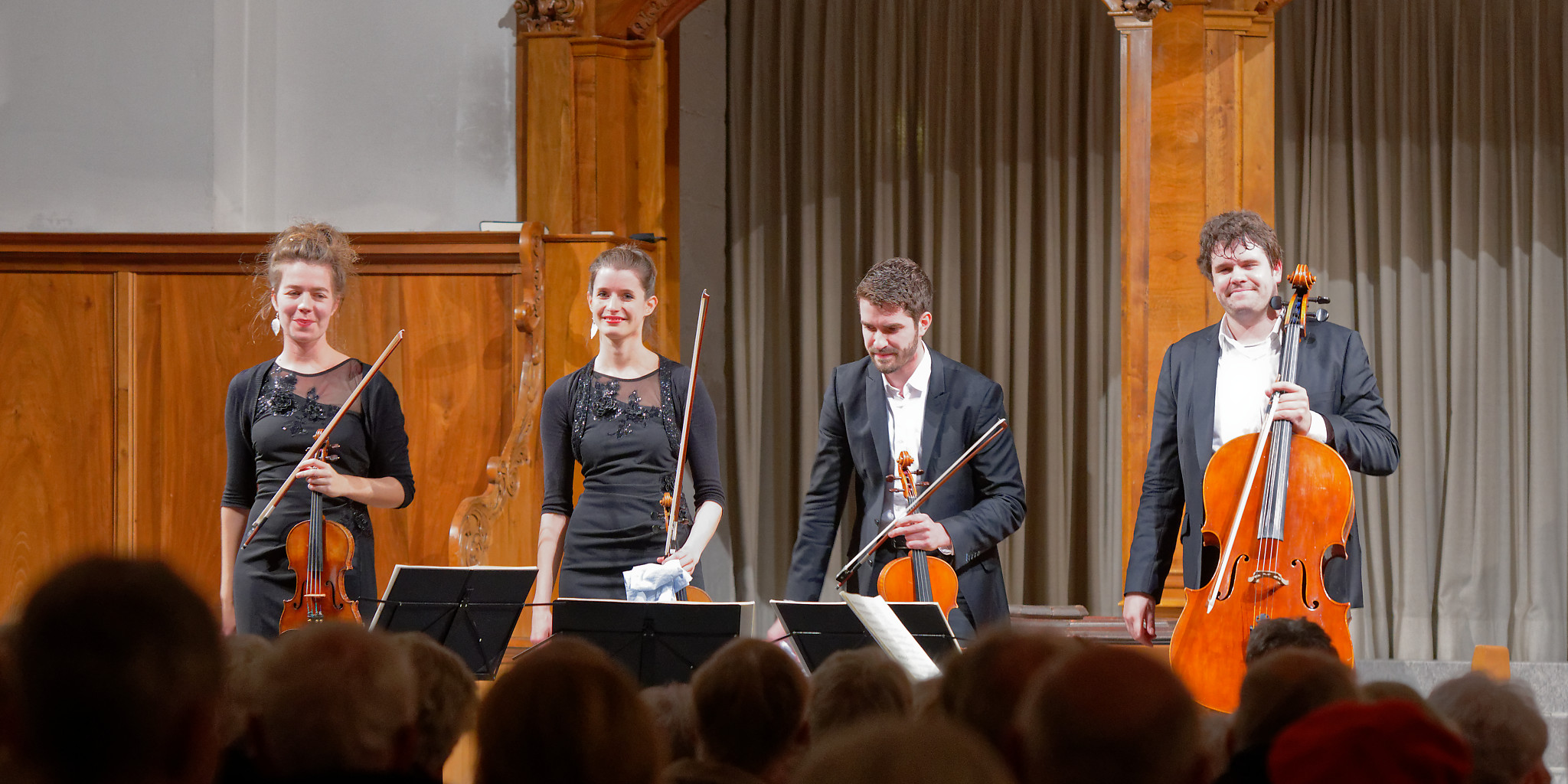Aris Quartett
Mendelssohn / Dvořák
St.Peter, Zurich, 2018-10-28

2018-11-04 — Original posting
Stilvoller Auftritt für Mendelssohn und Dvořák — Zusammenfassung
Nur selten trifft man auf ein Streichquartett, das derart stilvoll auftritt: die Herren an Viola und Cello einheitlich im Erscheinungsbild, die beiden Violinistinnen identisch und äußerst geschmackvoll gekleidet, vom Ohrschmuck bis zu den Schuhen: eine Freude allein schon für das Auge. Und doch entstand nicht der Eindruck eines “Fashion Statements” zum Selbstzweck.
Ensemblespiel reduziert sich nicht nur auf rhythmische Koordination. Es verlangt das miteinander Musizieren aus einem Geist, aus dem gleichen Verständnis. Dem Aris Quartett gelang das weitgehend. Ihr Spiel war einheitlich in Dynamik und Artikulation, im Formen von Motiven und Phrasen, wie auch im Gleichgewicht von Stimmen und Klangfülle. Das alles zeigt, wie das Quartett in den 9 Jahren seines Bestehens zusammengewachsen ist.
Energisch, fliessend, mit Ausdruck und subtiler Agogik interpretierte das Ensemble das op.13 von Mendelssohn. Leider war die Artikulation zu weich, das Tempo in den schnellen Sätzen zu hoch für diesen Kirchenraum. Zusätzlich setzten die Spieler sehr oft “bauchige” Noten. Für den Zuhörer war es schwierig, Details herauszuhören. Dazu kam, dass das Vibrato (zu stark für Mendelssohn) die Intonation beeinflusste. Eine perkussivere Artikulation und weniger Vibrato hätten der Musik zum Vorteil gereicht.
Die eher schwammige Artikulation, sowie das starke Vibrato (das nicht nur die Intonation, sondern auch den harmonischen Zusammenklang trübte) passten nicht zu Dvořák’s op.106. Erst das Allegro con fuoco des Schlusssatzes mit seinem Schwung, seiner Lebendigkeit, seinen lebhaften Rhythmen “weckte” die Musiker und begeisterte das Publikum—eine faszinierende Komposition.
Die Intonation verbesserte sich schlagartig, als die Mitglieder des Aris Quartett in der Zugabe, Bachs Contrapunctus I aus der “Kunst der Fuge” nur noch ganz spärlich Vibrato einsetzten.
Table of Contents
Introduction, Artists
Another concert in the 2018/2019 series of string quartet recitals in Zurich’s St.Peter Church, organized by Hochuli Konzert AG. This one featured the Aris Quartett, with the following members:
- Anna Katharina Wildermuth, violin
- Noémi Zipperling, violin
- Caspar Vinzens, viola
- Lukas Sieber, cello
The Aris Quartett emerged 2009 in Frankfurt am Main. The ensemble studied with members of the former Alban Berg Quartett (1970 – 2008), the Buchberger Quartett (1974 – 2014), and of the Artemis Quartet (founded 1989). By now that their concert career is “in full swing”, with some 90 concerts per year. At the same time, the Aris and the Artemis Quartets continue to cooperate.
This was my first encounter with the ensemble. Even though not sold out, the concert was very well-attended. My wife and I had seats on the right-hand side, in the rear half, just under the edge of the organ balcony.
According to their Website, the cellist plays a cello from 1866 made by the French maker Jean-Baptiste Vuillaume (1798 – 1875). No information on the other instruments is given.
Program
The quartet recitals in this series are without intermission. On this day, the program featured two compositions, to which the artists added an encore:
- Mendelssohn: String Quartet No.2 in A minor, op.13
- Dvořák: String Quartet No.13 in G major, op.106, B.192
Concert & Review
Mendelssohn: String Quartet No.2 in A minor, op.13
Felix Mendelssohn Bartholdy (1809 – 1847) composed his String Quartet No.2 in A minor, op.13 in 1827, at age 18. The composition has four movements:
- Adagio – Allegro vivace
- Adagio non lento
- Intermezzo: Allegretto con moto – Allegro di molto
- Presto – Adagio non lento
The Performance
As shown in the pictures, the Aris Quartett played with the two violins on the left, followed by the violist. The cellist sat at the right end of the open semi-circle. It soon became clear that the first violinist, Anna Katharina Wildermuth, was in control. Noémi Zipperling at the second violin was keeping close eye contact with her. To a slightly lesser degree, also the violist, Caspar Vinzens, followed that pattern. In contrast, the cellist, Lukas Sieber, had his eyes mostly on the sheet music or on the instrument. He seemed to keep contact with the others mostly through peripheral vision.
I. Adagio —
Based on the ensemble’s history / provenance (i.e., their teachers), I did not expect a radical, historically informed, let alone downright “crude”, “raw” performance (e.g., without any vibrato). Already the introductory Adagio confirmed this. The ensemble played with careful dynamics and gentle, mellow articulation.
I actually liked the sonority of the instruments, and the excellent balance within the ensemble. If the first violin seemed to dominate, that was in Mendelssohn’s disposition. However, there was a fair amount of vibrato, primarily in the first violin. To a lesser degree, this also applied to the cello. The Adagio is just 18 bars, and rolling demisemiquavers lead into the Allegro vivace:
Allegro vivace
Several factors impacted the listening experience. For one, the substantial reverberation proved fairly detrimental to the clarity of fast movements. Ideally, the artists would need to adjust the articulation, possibly also the tempo, in order to compensate for this. More importantly, “belly notes” appeared to dominate the ensemble’s articulation. They were almost everywhere. With this, tones appear to begin and end softly. This obscured the transition from one note to the next.
The phrasing often followed a similar pattern. Therefore, the music overall sounded both overblown and spongy at the same time. I was definitely longing for a more percussive articulation. Moreover, the vibrato mentioned above persisted, to a degree where it affected the intonation.
That said, the ensemble played with verve, the music was very expressive, the tempo fluent. Also I liked the ensemble’s use of agogics, e.g., in a little ritenuto around peak notes in a phrase.
II. Adagio non lento
Ensemble playing isn’t just about rhythmic coordination. Just as much it is about playing out of one spirit, one single mind. That’s where I think the Aris Quartett did very well. The playing was very coherent in dynamics, and articulation, in the shaping of motifs and phrases. All this demonstrated the collective experience, and how the ensemble has grown together. The artists carefully controlled the acoustic balance and the dynamics. It surely was a romantic view. Interestingly, in the fugato part, after the introduction, the artists (at least the middle voices) played the theme linearly, with little vibrato only. They added expressivity with the crescendo, though, and maintained their soft articulation.
The central Poco più animato appeared with emphasis and expression. For my taste, some of this was at the limit of sounding overblown. With the expressivity, the amount of vibrato grew again. And this seemed to affect the intonation. I wasn’t really happy with the middle part.
III. Intermezzo: Allegretto con moto – Allegro di molto
The Allegretto con moto theme sounded very atmospheric. It was entirely calm, with (mostly) just the first violin singing the tune, the others accompanying with pizzicato.
The central, Trio-like part formed a strong contrast. With its scurrying semiquaver figures, it is quite virtuosic. One interesting aspect is how Mendelssohn confuses the listener in the central part. One is torn between following either the jumping semiquaver motifs, or the seemingly accelerating long notes in the simultaneous canon of the contrasting voices.
The performance was excellent in the coordination. The handing-over of the short motifs between voices was seamless, hard to notice even. And the transition back to Tempo I was both natural and compelling. This was the best movement in the performance so far, despite the “romantic articulation” in melodies.
IV. Presto – Adagio non lento
The last movement followed attacca. It features a dramatic, operatic recitativo accompagnato. The tremolo accompaniment appears “inherited” directly from Beethoven. Here, the strong vibrato is a better fit, even though it still feels like at the limit to “too much”. Especially in combination with the frequent use of (prominent) portamento and the often “fluffy” articulation. On the other hand, the vibrato occasionally affected the intonation. And it also obscured the clarity of melodies in the (often dense) polyphonic segments. In the latter, the reverberating acoustics further affected the transparency.
In terms of coordination, and performing “out of a single, common spirit”, the movement was excellent. A concluding, short “Adagio come I” segment closes the circle to the first movement. I liked the compelling, step-wise transition back into that Adagio. The final bars themselves where calm and very atmospheric. Mendelssohn closes the composition in a comforting, conciliatory mood. The long silence after the last note showed how much the audience was touched by this.
Overall Rating: ★★★
Dvořák: String Quartet No.13 in G major, op.106, B.192
1895, after his return from the United States, Antonín Dvořák (1841 – 1904) composed his String Quartet No.13 in G major, op.106, B.192. In accordance with the “official” quartet numbering, the composer started this work prior to his String Quartet No.14 in A♭ major, op.105, B.193. After completing his op.106 (which premiered in October 1896), Dvořák resumed work on op.105, which became the quartet that he completed last. The string quartet op.106 features four movements:
- Allegro moderato
- Adagio ma non troppo
- Molto vivace
- Finale: Andante sostenuto – Allegro con fuoco
The Performance
I. Allegro moderato
The opening movement starts with a joyful “upwards” motif, p / softly, though rapidly building up to ff. The performance was certainly following the composer’s dynamics. However, Dvořák also notes pesante—which I missed here. The strength of the vibrato persisted in the second part of the concert. And so did the occasional intonation issues. The vibrato likely was the main factor affecting the intonation. It seemed that vibrato was serving as a principal means to express emotionality, along with “expressive dynamics”. The latter again led to a “fluffy” articulation with “belly notes” and soft articulation.
It’s a pity the artists didn’t use more “Slavonic”, agogic swaying between the bar lines. The performance overall lacked clarity.. And the acoustics didn’t help either.
I felt that the ensemble’s mellow articulation did not suit Dvořák’s quartet very well.
★★½
II. Adagio ma non troppo
Something I already noted in the Mendelssohn quartet: the first violin in particular has very nice, dark and full sonority. The tone had lots of character, especially on the G and D strings. This suited the beginning of the slow movement very well.
The ensemble’s soft articulation didn’t really help here. One could barely recognize the punctuations in the main melody line. It is possible that the acoustics had an impact here as well. However, artists should be able to compensate for this, at least in parts.
I liked the dynamics, the ensemble’s sonority in the ppp. Dvořák also offers the viola and the second violin a good chance to expose their qualities. Their sound was beautiful, especially on the low strings: I really loved this! Overall, I liked the performance here better than that of the first movement.
★★★
III. Molto vivace
In my notes, I again wrote about the excellent sonority of the instruments. And how well the instruments were matching in their sound quality. This was particularly evident in the A♭ major section, and in the Un poco meno mosso.
★★★
IV. Finale: Andante sostenuto – Allegro con fuoco
I wished the articulation had been clearer, more percussive. And again, I missed the swaying, “Slavonic” agogics, the “folk” tone. The vibrato often obscured not just the intonation, but also the harmonies.
In the initial Andante sostenuto, the articulation in the first violin was again somewhat spongy. However, after six bars, at the Allegro con fuoco, Dvořák’s enthralling music “takes over” with its drive, momentum, the vivid, lively rhythms. Both the musicians, as well as the listeners could hardly resist this. Even the somber, mysterious inserts can’t affect the overall impression of an excellent, fascinating composition.
★★★
Overall Rating: ★★★
Encore — Bach: From “Die Kunst der Fuge” (The Art of the Fugue), BWV 1080
As encore, the quartet turned to Johann Sebastian Bach (1685 – 1750). They chose Contrapunctus I from “Die Kunst der Fuge” (The Art of the Fugue), BWV 1080, a composition from the last years of Bach’s life. The description for this first of the fugues in the collection reads “simple, four-part fugue about the principal theme in its basic form”.
I was happy to note that the quartet used vibrato very sparingly. This of course suited the piece very well: it is absolute music in the best sense of the word! Why not extend restricted vibrato at least into the Mendelssohn quartet? I noted that with the limited vibrating, the intonation was much cleaner than in the preceding two works. The ensemble formed gentle, broad dynamic arches. These followed the density of the fugue texture, reaching a climax after the entry of the fourth voice. An artfully harmonious interpretation—thanks for this redeeming addition!











